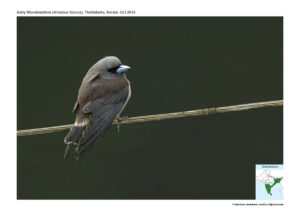Ashy Woodswallow

Ashy Woodswallow Artamus fuscus
Etymology :
- Artamus : Greek word for Butcher. The woodswallows were formerly known as swallow-shrikes, combining the characters of swallows and of shrikes (butcherbirds)
- Fuscus : Latin word for Brown colour
Vernacular name :Hindi: Tadiababeel, Ababil-Latora, Ben: Tal charai, Chatak-anjana, Lepcha: Silliangechi pho, Bangladesh: Mura sing, Guj: Rakhodiababil-latoro, Ababillatoro, Ta: Madam pura, Te: Tad/Tadi pitta, Mal: Enakkattevan, Sinh: Tal gas kurulla, Mar: RakhiRanpakoli
Distribution in India: Resident in East, South East and Southern parts ofIndia.
Description: Size of 16–19 cm; wt. of 37–42 g. It has slate-grey head with darker mask (lores and area around eye), greyish-maroon mantle and pinkish-grey underparts.It has white-tipped tail with narrow greyish-white horseshoe-shaped band across uppertail-coverts; iris is dark brown; billis pale blue-grey, tip is black; legs are grey to dark grey. Both the sexes are similar. The juvenile resembles adult, but has browner upperparts, with buff feather fringes on mantle, wing-coverts and remiges, and pale buffish-grey throat and underparts with distinct brownish barring.
Habitat: It is found in open wooded country, often with palm trees, also cultivations. It is found up to 2100 m.
Food habits: It eats insects and berries. It catches most of its prey in flight. It glides and circles in air in search of food items; also sallies from treetop or other perch, pursuing insects in flight. Insects are caught in the beak, transferred and held in their feet, torn up with their bill and swallowed without returning to the perch.Sometimes captures items on ground or other solid substrate. It forages singly, in pairs and in small flocks.
Breeding habits: They breed in Mar–Jul in India, Feb–Jun in Sri Lanka. The nest is a shallow loose cup of rootlets and other fibrous material, placed above ground, often at junction of palm frond with trunk; occasionally in tree hole; also in pylons. Both parents take part in nest building, incubation and feeding the young. They will mob larger birds such as crows and birds of prey that approach too close to the nesting birds They lay a clutch of 2–4 eggs.